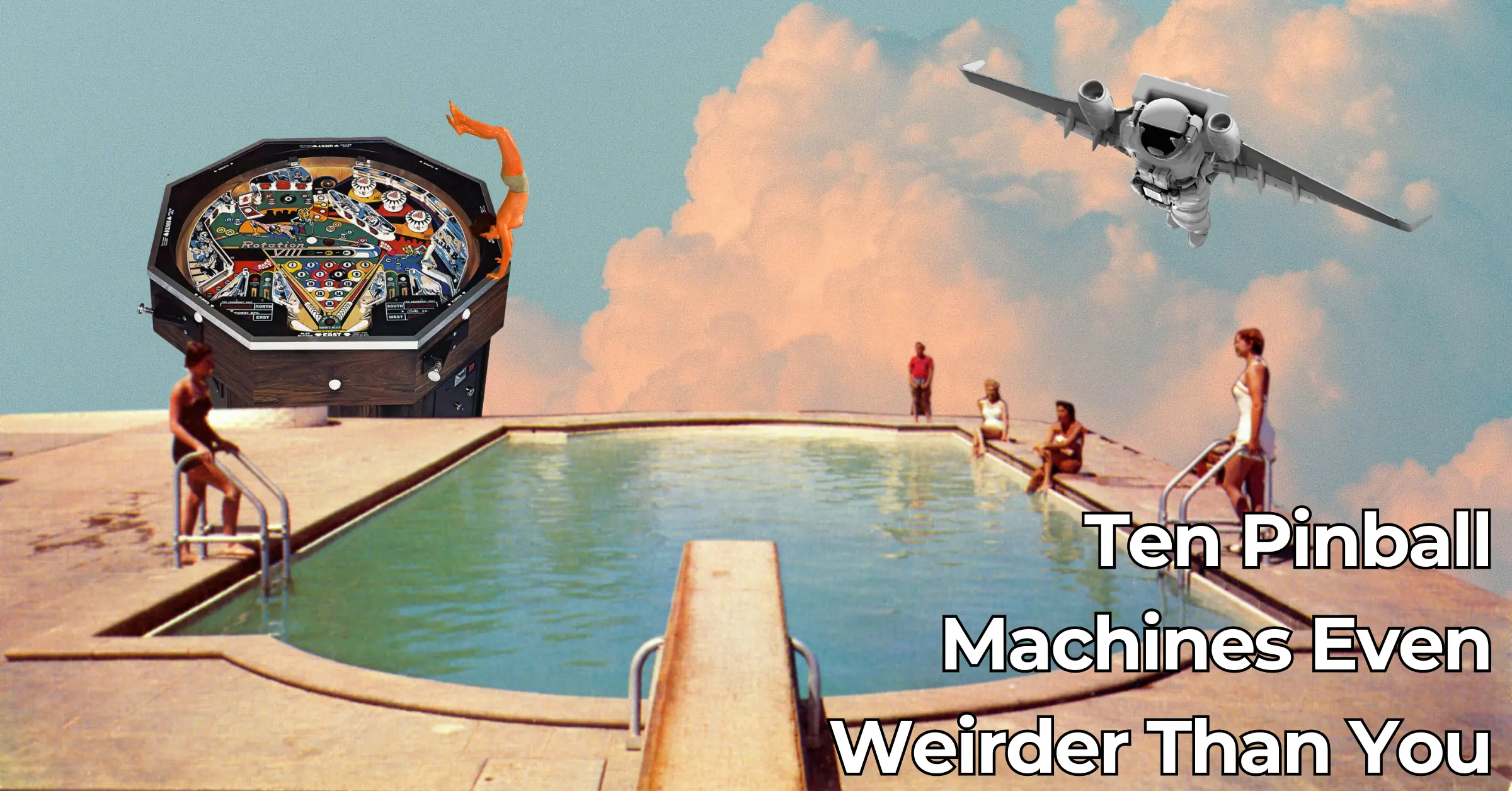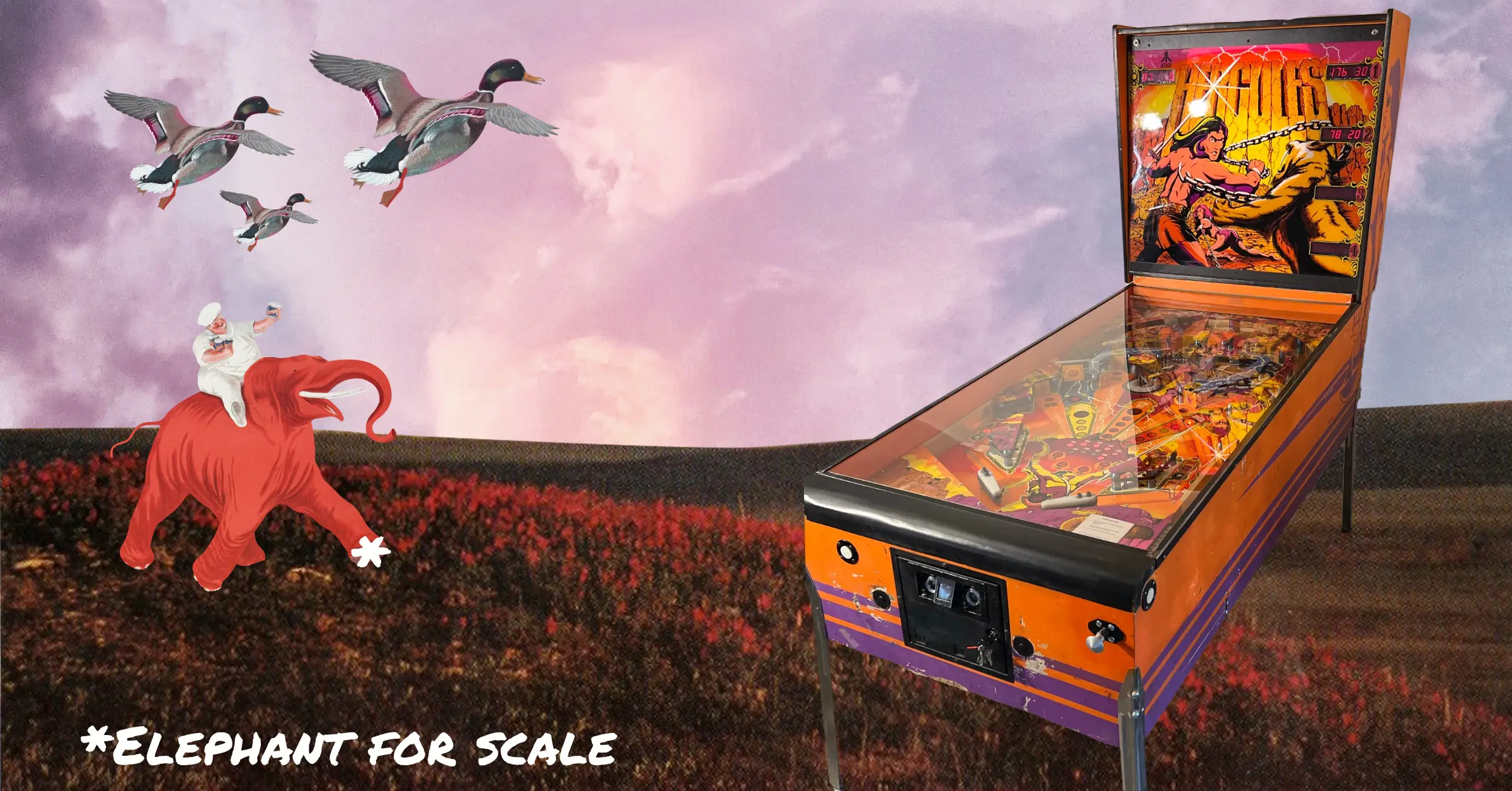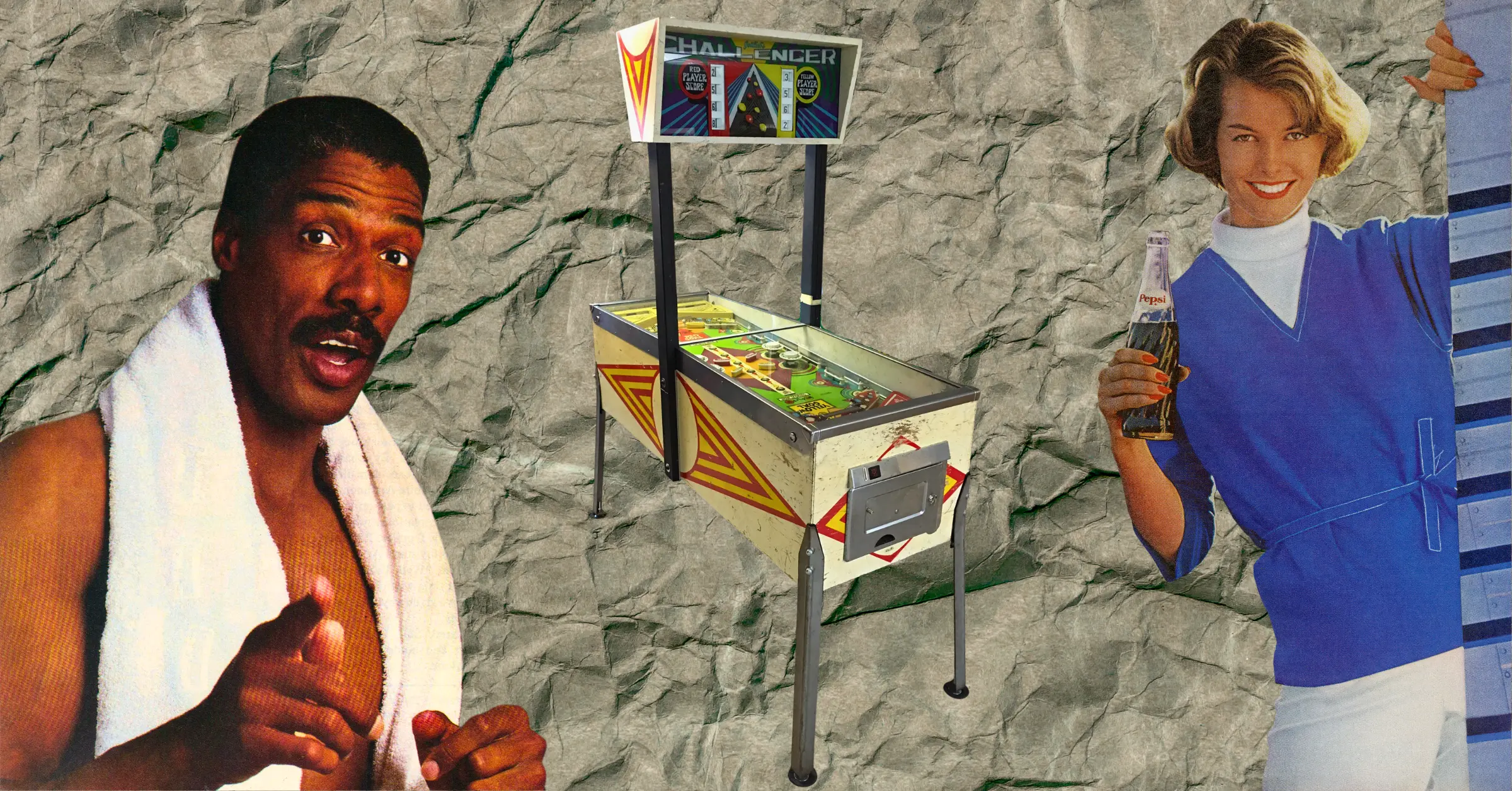Ten Pinball Machines Even Weirder Than You

Image Gallery
In today’s day and age, we see about a dozen new pinball machines hit the scene each year. Most of these games feature some unique toys or elements which make them stand out - but every now and again, we’ve seen some absolutely insane layouts, designs, or gimmicks which send one machine down in fame - or infamy - for their unusual nature.
So, let’s take a look at ten of the weirdest pinball machines ever made. For this list, I’m disqualifying prototypes (e.g. Pinball Circus), experimental games that aren’t really pinball machines (e.g. Hyperball, Baby Pac-Man), and custom-made machines (e.g. homebrews, movie props, museum pieces, etc.). It can still be rare, but there must be more than just a couple of them.
Hercules (Atari, 1979)
- Manufacturer: Atari
- Game Design: Steve Bicker
- Artwork: Jim Kelly

The short-lived Atari pinball division has one major claim to fame: it put out the largest pinball machine ever produced. Hercules is legendary for its absurd size: while most machines measure roughly 4’ long, 2.5’ wide, and 6.5’ tall Hercules is 8’ long, 3’ wide, and 7’ tall. The wooden(!) flippers are enormous. The ball is a cue ball. The bumpers are strong enough to shake foundations. Maintaining the playfield requires rolling underneath the table on a creeper, as one would maintain a car. Hilariously, it still has a tilt bob, but I’m pretty sure only Hercules himself would be able to make that relevant.
Unfortunately, the appeal lies solely in its novelty. Make no mistake, it’s a very cool game to play, but it is an awful pinball machine. There’s no real strategy, ball control is borderline impossible, and gameplay primarily consists of waiting for the ball to roll somewhere near the flippers. That said, it’s still a very cool experience, just not a good game. I still have fun playing it, but that’s just for how absurd the experience is. It is a rare game, but operators seldom keep them hidden. After all, “come play the world’s largest pinball machine” is a pretty magnetic draw.
Orbitor 1 (Stern, 1982)
- Manufacturer: Stern
- Game Design: Joe Joos Jr.
- Mechanics: Joe Joos Jr.

For those who seek to get their games as level as humanly possible, Orbitor 1 might prove a bit of a challenge. Rather than having a flat board of wood as the playfield, Orbitor 1 features a molded sheet of plexiglass, complete with divots, valleys, bowls, and the like. The result is a gameplay experience like no other: the ball swirls all over the place, curving and bending along with the surface of play.
While that’s the key oddity, it’s not the only one. The shooter lane starts about halfway down the cabinet to make space for the warped playfield. Rather than pop bumpers, the game features spinning rubber discs that snag the ball and throw it around. The playfield art itself isn’t just one image, either: it’s a 3D plastic mold of Mars’ surface. Admittedly, Orbitor 1, like Hercules, is better as a novelty than it is as a game. But the fun factor tends to stick around a bit longer.
Super Mario Bros. Mushroom World (Gottlieb, 1992)
- Manufacturer: Gottlieb
- Game Design: Ray Tanzier
- Artwork: Constantino Mitchell, Jeanine Mitchell, David Moore
- Code: Bob Wilson, Rand Paulin
- Sound: Craig Beierwaltes
- Music: Dave Zabriskie

Aside from being a redemption game - which already makes it pretty weird - Super Mario Bros. Mushroom World is incredibly small. The game was marketed as a kid’s game, so it could be purchased with shorter legs, making the game 30” tall (as opposed to the conventional 38”). Aside from that, it’s a pretty ordinary game - save for a lack of outlanes - and manages to pack an awful lot into a small space.
I have a soft spot for this game, having played it a ton when I was little. Honestly, it’s a pretty great design since it uses its space very well. Don’t get me wrong, it doesn’t feel like a full-sized table by any means, but it’s not trying to be. The shots feel tight and satisfying, the bumpers are action-packed and put in the right place, and it’s not overly gimmicky like many Gottliebs of this time were. Admittedly, it’s not super deep in terms of its complexity, the game is pretty much just “knock down drop targets.”
Blackwater 100 (Bally, 1988)
- Manufacturer: Bally
- Game Design: Dennis Nordman
- Artwork: Tony Ramunni
- Sound: Neil Falconer

Bally’s “6803” games are notable for their unusual layouts and odd designs - games like Escape from the Lost World could also appear on this list, but I think Blackwater 100 absolutely takes the cake as the strangest one. Let’s start with the obvious: Blackwater 100 features not one, but two mini playfields, one of which is located where most machines would have an apron. On this one, the flipper fires the ball upwards towards the player, rather than away from them. If that’s not enough, Blackwater 100 begins every ball as a 3-ball multiball, meaning you don’t plunge one ball to start each ball (or “heat” as the game calls them); you have to plunge three into the lock.
Blackwater 100 probably has the most unique layout of any conventional pinball machine I’ve ever seen. It’s also relentlessly hard. You can’t get back into multiballs, the lower mini-playfield is liable to instant drains, and most playfield features don’t carry over between balls. It’s much filthier than the theme would imply.
Rotation VIII (Midway, 1978)
- Manufacturer: Midway
- Game Design: Ron Halliburton
- Artwork: Rich Scafidi
- Mechanics: Tony Miller

Cocktail games were popular in the 70’s and 80’s for arcades: basically, rather than an upright monitor, the machine was more table-like, with a flat monitor facing upwards that the player would look down on. They’d often have two sets of control panels, so two players facing opposite each other could stay seated when taking turns playing a game, with the monitor mirroring the image so it would be facing whoever was currently playing. Some companies experimented with cocktail pinball machines - games like Night Moves that had no backbox and a smaller footprint - but faced one strange issue. How do multiple players take turns at a pinball cocktail table?
Well, Rotation VIII was the answer: the playfield was circular and would rotate to face whoever was currently playing. There were four sides to the machine, each of which had its own set of flipper buttons and plunger. When one player finished their ball, the machine would swivel around to face the next player. It’s not the first machine to have a rotating playfield - Spectra IV technically came first - this one is special for being automatic.
Challenger (Gottlieb, 1971)
- Manufacturer: Gottlieb
- Concept: Wayne Neyens
- Game Design: Alvin Gottlieb
- Artwork: Gordon Morison

One of the earliest head-to-head pinball machines, Challenger has two sets of flipper buttons at the opposite ends of the table, and a score display above the table like a traditional air hockey scoreboard. Two players play against each other, head-to-head, at the same time. Now, head-to-head games aren’t really that unique - Williams put out Joust and Alvin G put out Soccer-Ball, both of which have similar playstyles.
Challenger is special for being an EM game, as well as for the method of play. Whereas the others have a triangular-prism shaped playfield (i.e. slants face both players with a peak in the middle), Challenger’s entire playfield tilts back and forth to favor whoever’s currently scoring. Very unusual indeed, even for head-to-head games.
Safe Cracker (Bally, 1996)
- Manufacturer: Bally
- Concept/Game Design: Pat Lawlor
- Artwork: John Youssi
- Sound/Music: Dan Forden
- Code: Dean Grover, Matt Coriale
- Mechanics: John Krutsch, Carl Biagi

With the pinball industry experiencing a slow decline, Bally opted to try a new sort of game with Safe Cracker. Like Mushroom World, this is a significantly smaller machine than most - but wasn’t catered to children. While it retained the outlanes that Mushroom World lacked, Safe Cracker featured smaller flippers and a significantly more elaborate layout. More unusual still, Safe Cracker’s default setting does away with the traditional 3-ball play, instead awarding the player 45 seconds of guaranteed playtime, ending the game after the player drains with no time on the clock.
Safe Cracker’s main story has you play as a bank robber, and by completing assorted playfield objectives, you gain access to a “board game” on the backglass. Up there, you flip the flippers to “roll dice” and move around the board in an attempt to reach the safe in the center, with different spaces having different awards and/or penalties on them. Should you successfully reach the center, you’re awarded with a “Magic Token,” a special custom-made token for the game that you can either keep as a souvenir or can re-insert into the machine to play a special game. It’s interesting because it’s very much a pinball game, but is a really fresh and unique concept, tied together with a great soundtrack and callouts. It does get a little old after a while, though.
Varkon (Williams, 1982)
- Manufacturer: Williams
- Game Design: Mike Kubin, Tony Kraemer
- Artwork: Seamus McLaughlin
- Code: Bill Pfutzenreuter

At first glance, Varkon looks like a standard upright arcade cabinet. Then you get up close and realize that it’s actually a pinball machine pretending to be a video game. The playfield is reflected with a mirror, projecting a vertical image of the machine to the player. It’s very bizarre to play: Varkon has joysticks instead of flipper buttons, the playfield is much smaller than a conventional machine, the printed text on the playfield is inverted for the mirror, and above all else, it has a second playfield underneath the main one.
Only 90 were ever made, making Varkon a bit of a white whale among pinball fans. It’s a cool game for sure, but it’s not exactly a stellar machine, more just an incredibly novel experience. It would’ve been cool to see this lined up with some other upright cabinets, though. I’d say it probably never tricked anyone with its disguise.
Spectrum (Bally, 1982)
- Manufacturer: Bally
- Game Design: Claude Fernandez
- Artwork: Margaret Hudson
- Code: Rehman Merchant

You might think Spectrum isn’t that odd of a game, considering that it has a relatively ordinary layout. But, there are a few oddities that stand out. For one, the game has no plunger. The ball just kicks out from the drain. To assist this, there are no outlanes. The flippers are basically attached to the apron, meaning you can only lose balls down the middle. There’s also the odd choice of having the flippers play a sound effect every time you flip. Finally, the game has five saucers: two of them return the balls to the “inlanes,” and the other three kick the balls to the two inlane saucers. The game needs this many saucers, of course, because the game has three balls inside it, yet has no multiball play.
From a gameplay perspective, Spectrum is incredibly bizarre - the playfield is extremely barren, and the objectives mainly consist of shooting at four banks of colored targets to try and find the correct color to break a computer code or something. It’s kind of a bonus game, except only one target bank advances bonus, the game doesn’t tell you which, and you can get “clues” which mainly entail the game telling you what not to shoot. It’s very unusual, and probably a precursor to Bally’s truly bizarre experiments of the late 80’s and early 90’s.
Banzai Run (Williams, 1988)
- Manufacturer: Williams
- Concept: Pat Lawlor
- Game Design: Larry DeMar, Pat Lawlor
- Artwork: Mark Sprenger
- Code: Ed Boon, Larry DeMar
- Mechanics: John Krutsch
- Sound/Music: Brian Schmidt

This one doesn’t really need much of an introduction - aside from having one of the best soundtracks of all time, Banzai Run’s key feature is its backbox which holds a vertical playfield inside it. The upper playfield - or “Banzai Hill,” as the game calls it, is an incredibly unique experience, as the physics up top are unlike any other playfield I’ve ever really played on. If that’s not enough, this is the debut design by pinball legend Pat Lawlor, setting off a career that would be followed up with classics like Funhouse, Whirlwind, The Addams Family, and Twilight Zone.
But perhaps even stranger than that, while many games on this list heavily rely on their gimmicks to keep them interesting, Banzai Run merely leans on the Hill to keep itself fun. Don’t get me wrong, it’s the defining feature of this game - but if you play Banzai Run enough, you’ll start to forget about how unusual it is because the game itself is such a blast. It’s also a game that you might even see played in competition - so if you want to learn how to play it, be sure to check out our Banzai Run guide!








.webp)
.webp)
